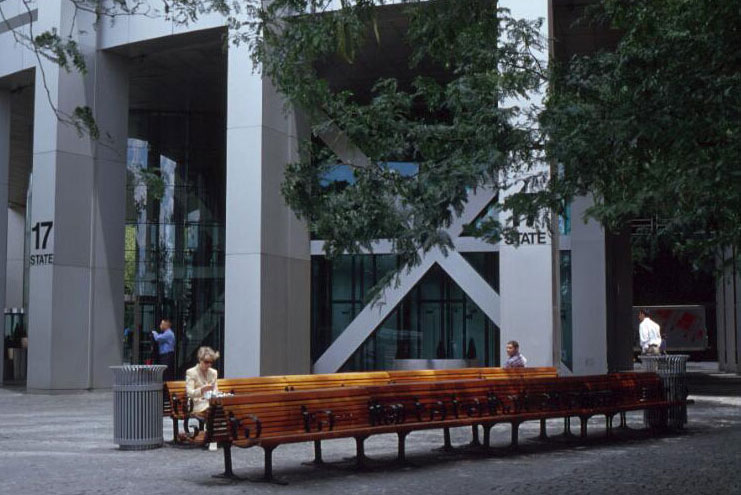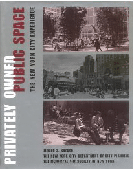
17 State Street
Located on a lot bounded by the south side of Pearl Street and the east side of State Street, the array of privately owned public spaces at 17 State Street — urban plaza, sidewalk widening, arcade, and public exhibit space — is a marvelous illustration of the diversity within the City’s public space inventory. Two of the four spaces are fully outdoors, one is covered but otherwise open to the air, and the fourth is fully indoors. Two have required amenities, the others do not. Two were approved “as-of-right” by the Department of Buildings and received zoning bonuses, one was certified by the Chairperson of the City Planning Commission and received a zoning bonus, the fourth was a condition of a special permit issued by the Board of Standards and Appeals and was not bonused. In short, by examining these spaces, much can be learned about the City’s program for privately owned public space.

Old and new are juxtaposed here. Sandwiched between the silvery metallic tower to the west and the similarly clad one-story shed to the east is the main portion of urban plaza. Its swirling rough cobblestone paving and rows of antique park-style fixed wood benches want to evoke the historical city, even as the office building, like a small version of Citigroup Center, is poised for takeoff on its multiple piers. A bust of author Herman Melville, who was born at this site, sits in a plexiglass-covered perch entombed within the one-story shed. The romance of the park bench is interrupted by the metal rail dividers, intended to make slouching difficult and horizontal sleeping impossible, a reminder of pressing present-day social issues. An unusually tall, capacious arcade occupies much of the tower’s underbelly, encircling the X-beamed, glass-enclosed lobby core that blocks views from the urban plaza west across State Street and Battery Park to the Hudson River and the Statue of Liberty in the distance. Outside stairs in the arcade next to Pearl Street go somewhere, but it is impossible to tell exactly where from the vantage point of the arcade or the adjacent sidewalk widening.
History is literally on display inside the shed to the east, where a public exhibit space called “New York Unearthed,” open Monday through Friday, 12:00 noon to 6:00 p.m., serves as the South Street Seaport Museum’s off-site urban archaeology museum. A “six-pounder,” a cannon dumped into the East River before 1789 and recovered from its bottom, pointedly welcomes the user at the entrance. Pairing archaeological objects with dioramas, the glass-enclosed displays in this tiny climate-controlled room offer slices of New York’s history over 6,000 years, covering the city’s role as a hunting ground for Native Americans, as a Dutch and English trading post, as an immigrant city filled with tenements, and as home to one of the first free-black communities.
Past the guard and down a long staircase is the basement level, where professional archaeologists are visibly at work in a conservation laboratory, happy to talk with visitors about the museum’s collection of artifacts. On the wall is a section model showing what lies underneath present-day streets and buildings including, for example, a privy from the 1810s and old walls. There is also a modern operational restroom toward the back. A room normally featuring a projection show was closed at a recent site visit as the museum searches for $12,000 for a new projector. Those intrigued by seeing more of what lies underneath the city’s streets and lots may venture several blocks east to the Goldman Sachs building at 85 Broad Street, where ground-level plexiglass hatches in the public space reveal archaeological objects discovered during the construction of that tower.
How did 17 State Street’s public exhibit space become a required privately owned public space? When the developer of the building sought a special permit in 1986 from the Board of Standards and Appeal to modify the height and setback zoning regulations as applied to its building, one of the Board’s conditions was that the developer agree to provide this space. Museums or satellite branches may be found at several other public spaces, including the Museum of American Folk Art in the covered plaza at Two Lincoln Square, a branch of the Whitney Museum of American Art at the Philip Morris covered pedestrian space, and the Newseum at the covered pedestrian space of 590 Madison Avenue.

 (5 votes, average: 4.00 out of 5)
(5 votes, average: 4.00 out of 5)
The bust of Herman Melville was unceremoniously removed by workers on the evening of Tuesday, September 6, 2016. A metallic panel matching the other ones on the wall where the bust stood replaces the niche. The public exhibit space “New York Unearthed” has been closed for a number of years.